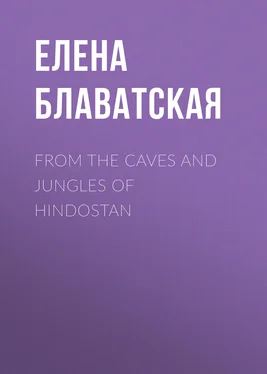Елена Блаватская - From the Caves and Jungles of Hindostan
Здесь есть возможность читать онлайн «Елена Блаватская - From the Caves and Jungles of Hindostan» — ознакомительный отрывок электронной книги совершенно бесплатно, а после прочтения отрывка купить полную версию. В некоторых случаях можно слушать аудио, скачать через торрент в формате fb2 и присутствует краткое содержание. Жанр: Путешествия и география, История, foreign_edu, foreign_antique, foreign_prose, на английском языке. Описание произведения, (предисловие) а так же отзывы посетителей доступны на портале библиотеки ЛибКат.
- Название:From the Caves and Jungles of Hindostan
- Автор:
- Жанр:
- Год:неизвестен
- ISBN:нет данных
- Рейтинг книги:5 / 5. Голосов: 1
-
Избранное:Добавить в избранное
- Отзывы:
-
Ваша оценка:
- 100
- 1
- 2
- 3
- 4
- 5
From the Caves and Jungles of Hindostan: краткое содержание, описание и аннотация
Предлагаем к чтению аннотацию, описание, краткое содержание или предисловие (зависит от того, что написал сам автор книги «From the Caves and Jungles of Hindostan»). Если вы не нашли необходимую информацию о книге — напишите в комментариях, мы постараемся отыскать её.
From the Caves and Jungles of Hindostan — читать онлайн ознакомительный отрывок
Ниже представлен текст книги, разбитый по страницам. Система сохранения места последней прочитанной страницы, позволяет с удобством читать онлайн бесплатно книгу «From the Caves and Jungles of Hindostan», без необходимости каждый раз заново искать на чём Вы остановились. Поставьте закладку, и сможете в любой момент перейти на страницу, на которой закончили чтение.
Интервал:
Закладка:
We have twice been present at the ceremonies of dying, and once of burial, if I may be permitted to use such an incongruous term. In this respect the Parsees are much more tolerant than the Hindus, who are offended by the mere presence at their religious rites of an European. N. Bayranji, a chief official of the tower, invited us to his house to be present at the burial of some rich woman. So we witnessed all that was going on at a distance of about forty paces, sitting quietly on our obliging host's verandah. While the dog was staring into the dead woman's face, we were gazing, as intently, but with much more disgust, at the huge flock of vultures above the dakhma, that kept entering the tower, and flying out again with pieces of human flesh in their beaks. These birds, that build their nests in thousands round the Tower of Silence, have been purposely imported from Persia. Indian vultures proved to be too weak, and not sufficiently bloodthirsty, to perform the process of stripping the bones with the despatch prescribed by Zoroaster. We were told that the entire operation of denuding the bones occupies no more than a few minutes. As soon as the ceremony was over, we were led into another building, where a model of the dakhma was to be seen. We could now very easily imagine what was to take place presently inside the tower. In the centre there is a deep waterless well, covered with a grating like the opening into a drain. Around it are three broad circles, gradually sloping downwards. In each of them are coffin-like receptacles for the bodies. There are three hundred and sixty-five such places. The first and smallest row is destined for children, the second for women, and the third for men. This threefold circle is symbolical of three cardinal Zoroastrian virtues—pure thoughts, kind words, and good actions. Thanks to the vultures, the bones are laid bare in less than an hour, and, in two or three weeks, the tropical sun scorches them into such a state of fragility, that the slightest breath of wind is enough to reduce them to powder and to carry them down into the pit. No smell is left behind, no source of plagues and epidemics. I do not know that this way may not be preferable to cremation, which leaves in the air about the Ghat a faint but disagreeable odour. The Ghat is a place by the sea, or river shore, where Hindus burn their dead. Instead of feeding the old Slavonic deity "Mother Wet Earth" with carrion, Parsees give to Armasti pure dust. Armasti means, literally, "fostering cow," and Zoroaster teaches that the cultivation of land is the noblest of all occupations in the eyes of God. Accordingly, the worship of Earth is so sacred among the Parsees, that they take all possible precautions against polluting the "fostering cow" that gives them "a hundred golden grains for every single grain." In the season of the Monsoon, when, during four months, the rain pours incessantly down and washes into the well everything that is left by the vultures, the water absorbed by the earth is filtered, for the bottom of the well, the walls of which are built of granite, is, to this end, covered with sand and charcoal.
The sight of the Pinjarapala is less lugubrious and much more amusing. The Pinjarapala is the Bombay Hospital for decrepit animals, but a similar institution exists in every town where Jainas dwell. Being one of the most ancient, this is also one of the most interesting, of the sects of India. It is much older than Buddhism, which took its rise about 543 to 477 B.C. Jainas boast that Buddhism is nothing more than a mere heresy of Jainism, Gautama, the founder of Buddhism, having been a disciple and follower of one of the Jaina Gurus. The customs, rites, and philosophical conceptions of Jainas place them midway between the Brahmanists and the Buddhists. In view of their social arrangements, they more closely resemble the former, but in their religion they incline towards the latter. Their caste divisions, their total abstinence from flesh, and their non-worship of the relics of the saints, are as strictly observed as the similar tenets of the Brahmans, but, like Buddhists, they deny the Hindu gods and the authority of the Vedas, and adore their own twenty-four Tirthankaras, or Jinas, who belong to the Host of the Blissful. Their priests, like the Buddhists', never marry, they live in isolated viharas and choose their successors from amongst the members of any social class. According to them, Prakrit is the only sacred language, and is used in their sacred literature, as well as in Ceylon. Jainas and Buddhists have the same traditional chronology. They do not eat after sunset, and carefully dust any place before sitting down upon it, that they may not crush even the tiniest of insects. Both systems, or rather both schools of philosophy, teach the theory of eternal indestructible atoms, following the ancient atomistic school of Kanada. They assert that the universe never had a beginning and never will have an end. "The world and everything in it is but an illusion, a Maya," say the Vedantists, the Buddhists, and the Jainas; but, whereas the followers of Sankaracharya preach Parabrahm (a deity devoid of will, understanding, and action, because "It is absolute understanding, mind and will"), and Ishwara emanating from It, the Jainas and the Buddhists believe in no Creator of the Universe, but teach only the existence of Swabhawati, a plastic, infinite, self-created principle in Nature. Still they firmly believe, as do all Indian sects, in the transmigration of souls. Their fear, lest, by killing an animal or an insect, they may, perchance, destroy the life of an ancestor, develops their love and care for every living creature to an almost incredible extent. Not only is there a hospital for invalid animals in every town and village, but their priests always wear a muslin muzzle, (I trust they will pardon the disrespectful expression!) in order to avoid destroying even the smallest animalcule, by inadvertence in the act of breathing. The same fear impels them to drink only filtered water. There are a few millions of Jainas in Gujerat, Bombay, Konkan, and some other places.
The Bombay Pinjarapala occupies a whole quarter of the town, and is separated into yards, meadows and gardens, with ponds, cages for beasts of prey, and enclosures for tame animals. This institution would have served very well for a model of Noah's Ark. In the first yard, however, we saw no animals, but, instead, a few hundred human skeletons—old men, women and children. They were the remaining natives of the, so-called, famine districts, who had crowded into Bombay to beg their bread. Thus, while, a few yards off, the official "Vets." were busily bandaging the broken legs of jackals, pouring ointments on the backs of mangy dogs, and fitting crutches to lame storks, human beings were dying, at their very elbows, of starvation. Happily for the famine-stricken, there were at that time fewer hungry animals than usual, and so they were fed on what remained from the meals of the brute pensioners. No doubt many of these wretched sufferers would have consented to transmigrate instantly into the bodies of any of the animals who were ending so snugly their earthly careers.
But even the Pinjarajala roses are not without thorns. The graminivorous "subjects," of course, could mot wish for anything better; but I doubt very much whether the beasts of prey, such as tigers, hyenas, and wolves, are content with the rules and the forcibly prescribed diet. Jainas themselves turn with disgust even from eggs and fish, and, in consequence, all the animals of which they have the care must turn vegetarians. We were present when an old tiger, wounded by an English bullet, was fed. Having sniffed at a kind of rice soup which was offered to him, he lashed his tail, snarled, showing his yellow teeth, and with a weak roar turned away from the food. What a look he cast askance upon his keeper, who was meekly trying to persuade him to taste his nice dinner! Only the strong bars of the cage saved the Jaina from a vigorous protest on the part of this veteran of the forest. A hyena, with a bleeding head and an ear half torn off, began by sitting in the trough filled with this Spartan sauce, and then, without any further ceremony, upset it, as if to show its utter contempt for the mess. The wolves and the dogs raised such disconsolate howls that they attracted the attention of two inseparable friends, an old elephant with a wooden leg and a sore-eyed ox, the veritable Castor and Pollux of this institution. In accordance with his noble nature, the first thought of the elephant concerned his friend. He wound his trunk round the neck of the ox, in token of protection, and both moaned dismally. Parrots, storks, pigeons, flamingoes—the whole feathered tribe—revelled in their breakfast. Monkeys were the first to answer the keeper's invitation and greatly enjoyed themselves. Further on we were shown a holy man, who was feeding insects with his own blood. He lay with his eyes shut, and the scorching rays of the sun striking full upon his naked body. He was literally covered with flies, mosquitoes, ants and bugs.
Читать дальшеИнтервал:
Закладка:
Похожие книги на «From the Caves and Jungles of Hindostan»
Представляем Вашему вниманию похожие книги на «From the Caves and Jungles of Hindostan» списком для выбора. Мы отобрали схожую по названию и смыслу литературу в надежде предоставить читателям больше вариантов отыскать новые, интересные, ещё непрочитанные произведения.
Обсуждение, отзывы о книге «From the Caves and Jungles of Hindostan» и просто собственные мнения читателей. Оставьте ваши комментарии, напишите, что Вы думаете о произведении, его смысле или главных героях. Укажите что конкретно понравилось, а что нет, и почему Вы так считаете.












